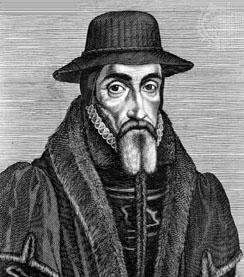John Foxe's apocalyptic thought facts for kids
John Foxe was an English church leader in the 1500s. He is best known for his book Actes and Monuments, which told stories of people who died for their faith. Foxe also wrote a lot about the meaning of the Apocalypse. This means he tried to understand the future events described in the Book of Revelation in the Bible. He wrote about this at the start of his career in the 1550s and again near the end, with his book Eicasmi in 1587, the year he passed away.
Contents
Understanding Foxe's Ideas
What Influenced Foxe?
Before Foxe, another writer named John Bale had ideas about the future. In the 1540s, Bale said that the Protestant Church of England was fighting a big battle. This battle was against what he called the "false church" of Catholicism. Bale used the Book of Revelation to support his views. England was seen as a special "elect nation" chosen by God. This idea was quite unique among Protestant countries.
Foxe's Main Beliefs
Foxe's ideas became very popular in the Church of England for many years. He believed that the English people were fighting a war against the Antichrist. The Antichrist was seen as a powerful enemy of Christianity. Foxe thought that the English leader, Elizabeth I of England, was like a "Christian Emperor." This was similar to how Constantine I was seen in ancient times.
Later, some people within the Church of England, like Thomas Brightman, started to question Foxe's views. Others outside the church, especially John Napier, also disagreed. But for a long time, Foxe's ideas stayed important. His work supported the Church of England and its leaders, including the Marian martyrs who died for their beliefs. Foxe was also against persecution, which meant he didn't like people being punished for their religion.
Foxe's Writings on the Future
His Early Play: Christus Triumphans
Foxe wrote a Latin play called Christus Triumphans in 1556. This play was like a preview of his later ideas about Christian history. It was called a comœdia apocalyptica, which means an "apocalyptic comedy." The play had 29 scenes and ended with a feeling of hope for the future.
The last part of the play, which was meant to be unfinished, showed events from the Book of Revelation. It connected these events to the Protestant Reformation and, in a symbolic way, to England at that time. Some historians think that the famous writer Edmund Spenser might have gotten his own ideas about the future from Foxe's play.
Tables in Actes and Monuments
Later versions of Foxe's famous book, Actes and Monuments, included special tables. These tables showed the meaning of numbers found in the Book of Revelation. They also had a timeline that showed when the Church had faced persecution. This helped people understand Foxe's view of history and the future.
Understanding Time and the Future
What is Amillennialism?
Foxe was what is called an "amillennial historicist." This is a bit different from being a simple amillennialist. These terms relate to how people understand the "millennium" mentioned in the Bible. The millennium is a period of a thousand years.
Many people in Tudor England believed the Christian millennium had already happened in the past. Foxe also believed this. He was part of the main group that disagreed with "premillennialist" ideas. Premillennialists believed the millennium was still to come. Later writers like Arthur Dent, George Gifford, and John Napier held these premillennialist views.


